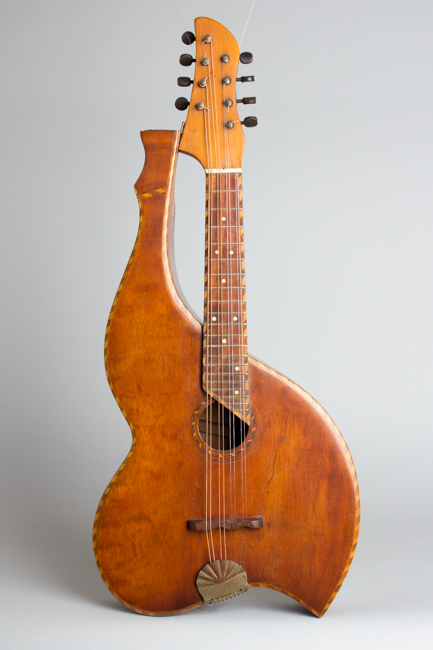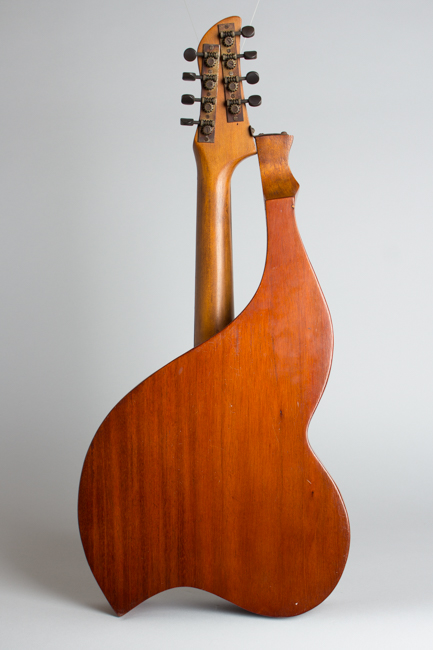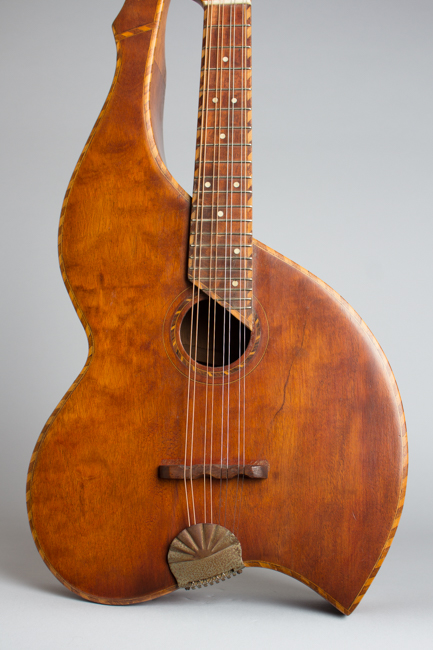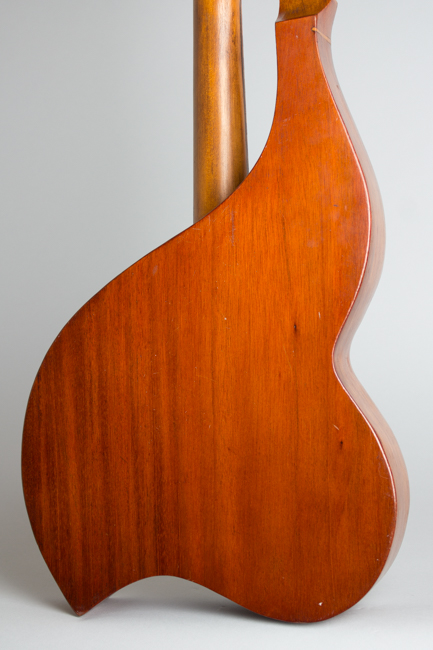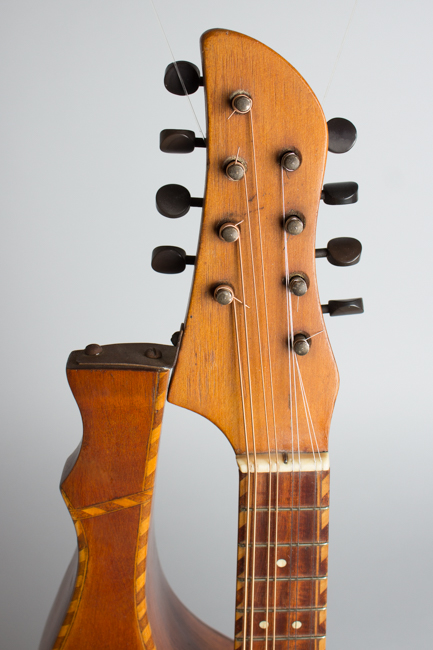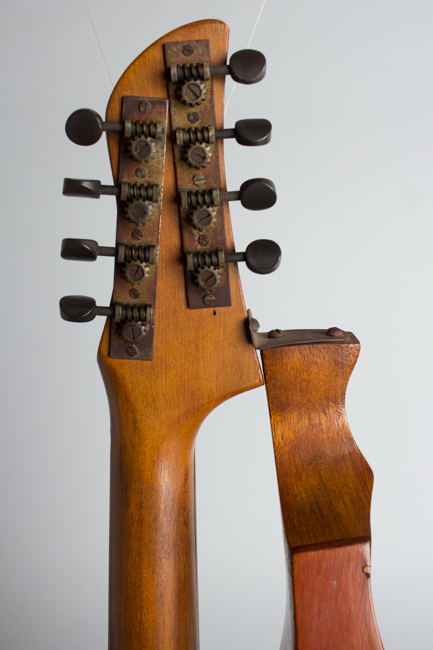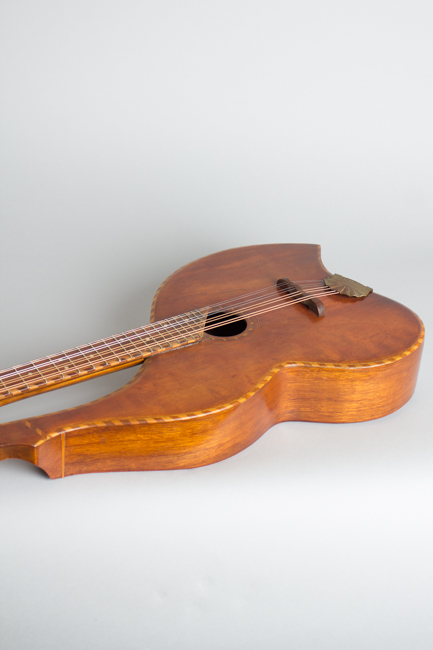Knutsen Harp Mandolin , c. 1912
This item has been sold.
Item # 8086
Prices subject to change without notice.
Knutsen Harp Mandolin, c. 1912, made in Seattle, WA, natural varnish finish, Koa wood body, poplar neck.
One of America's most creative (if least celebrated) early 20th century luthiers was Chris Knutsen, who hand-built his always amazingly eccentric instruments on the West Coast from the 1890s up into the 1920s. His original design for a hollow-neck Hawaiian guitar was popularized by Hermann Weissenborn and his Symphony harp guitars by the Larson Brothers (under the Dyer label), but Knutsen himself never made the leap from craftsman to manufacturer. He tinkered endlessly with his unique and highly original stringed instrument concepts, and each completely handmade instrument is distinctive, often appearing to be built from found woods and whatever hardware was available.
This unusual Harp mandolin dates to around 1912, towards the end of Knutsen's fascination with harp guitars and similar instruments at a time when he was increasingly embracing the Hawaiian music trend. Although not a particularly Hawaiian-style instrument, this mandolin is built of Hawaiian koa wood, an early indicator of his shift in this direction. He built a series of similar designs labeled "The New Hawaiian Family," and this mandolin is an early example of this style. There are photographs of actual authentic Hawaiian musicians performing in the 1910s with Knutsen mandolins of this type.
The design is highly eccentric, but the instrument itself is a wonderful example of Knutsen's better work. The lines are fluid to the point of abstract shape; the headstock and harp extension to the body are entirely nonconventional with a liquid sculpture look. The unusually large body has typical signature Knutsen features, including a lower body extension on the treble side and a hollow upper body extension with a long sweeping curve from the tip down to the bottom body edge. The bridge is a floating carved affair, with the strings continuing on to a conventional tailpiece. The top is bound in Hawaiian-style "zipper" wood marquetry, and the fingerboard is bound the same way. The sound hole has multiple wooden rings with the largest being similar wood inlay.
The wood-bound fingerboard is inlaid with small dots and ends in an angled point over the sound hole. The neck is thicker than most mandolins with a nut width of 1 3/8". The profile is a fairly deep "C." The tuners have a typically Knutsen random air, mounted in echelon with enough pull to the bass side that the nut is secured with a pin to keep it from pulling the side. There is a metal bracket joining the headstock to the body extension secured with large wood screws, allowing a slight amount of neck angle adjustment.
The internal workmanship on this mandolin is cleaner and better executed than many of this maker's surviving creations, some of which have braces that appear to be random wood leftovers. Despite over 100 years of tension, the instrument remains solid. While obviously a supremely eccentric instrument, this is a good-playing and excellent-sounding piece of American musical art, a most striking Knutsen creation. The sound is quite good, with a deeper, sweeter tone than many mandolins due to the larger body cavity.
Overall length is 25 in. (63.5 cm.), 10 3/4 in. (27.3 cm.) wide at lower bout, and 2 3/4 in. (7 cm.) in depth, measured at side of rim. Scale length is 13 1/2 in. (343 mm.). Width of nut is 1 3/8 in. (35 mm.).
Considering its age and relative fragility, this unusual Knutsen creation remains in very fine original condition, showing not a lot of signs of use. There is corrosion to the metal parts, but overall the finish is in very good shape. The finishing on Knutsen instruments is often inconsistent; it is possible the top has been polished out and the neck worn down a bit, but it is difficult to say for sure. There has been some regluing at the eccentric neck/body junction (there is no heel), but everything is solid. Overall an exceptional example of one of the most eccentric mandolins ever made and a good-sounding (if wildly unconventional) piece of 8-string history. Excellent - Condition.
One of America's most creative (if least celebrated) early 20th century luthiers was Chris Knutsen, who hand-built his always amazingly eccentric instruments on the West Coast from the 1890s up into the 1920s. His original design for a hollow-neck Hawaiian guitar was popularized by Hermann Weissenborn and his Symphony harp guitars by the Larson Brothers (under the Dyer label), but Knutsen himself never made the leap from craftsman to manufacturer. He tinkered endlessly with his unique and highly original stringed instrument concepts, and each completely handmade instrument is distinctive, often appearing to be built from found woods and whatever hardware was available.
This unusual Harp mandolin dates to around 1912, towards the end of Knutsen's fascination with harp guitars and similar instruments at a time when he was increasingly embracing the Hawaiian music trend. Although not a particularly Hawaiian-style instrument, this mandolin is built of Hawaiian koa wood, an early indicator of his shift in this direction. He built a series of similar designs labeled "The New Hawaiian Family," and this mandolin is an early example of this style. There are photographs of actual authentic Hawaiian musicians performing in the 1910s with Knutsen mandolins of this type.
The design is highly eccentric, but the instrument itself is a wonderful example of Knutsen's better work. The lines are fluid to the point of abstract shape; the headstock and harp extension to the body are entirely nonconventional with a liquid sculpture look. The unusually large body has typical signature Knutsen features, including a lower body extension on the treble side and a hollow upper body extension with a long sweeping curve from the tip down to the bottom body edge. The bridge is a floating carved affair, with the strings continuing on to a conventional tailpiece. The top is bound in Hawaiian-style "zipper" wood marquetry, and the fingerboard is bound the same way. The sound hole has multiple wooden rings with the largest being similar wood inlay.
The wood-bound fingerboard is inlaid with small dots and ends in an angled point over the sound hole. The neck is thicker than most mandolins with a nut width of 1 3/8". The profile is a fairly deep "C." The tuners have a typically Knutsen random air, mounted in echelon with enough pull to the bass side that the nut is secured with a pin to keep it from pulling the side. There is a metal bracket joining the headstock to the body extension secured with large wood screws, allowing a slight amount of neck angle adjustment.
The internal workmanship on this mandolin is cleaner and better executed than many of this maker's surviving creations, some of which have braces that appear to be random wood leftovers. Despite over 100 years of tension, the instrument remains solid. While obviously a supremely eccentric instrument, this is a good-playing and excellent-sounding piece of American musical art, a most striking Knutsen creation. The sound is quite good, with a deeper, sweeter tone than many mandolins due to the larger body cavity.
Overall length is 25 in. (63.5 cm.), 10 3/4 in. (27.3 cm.) wide at lower bout, and 2 3/4 in. (7 cm.) in depth, measured at side of rim. Scale length is 13 1/2 in. (343 mm.). Width of nut is 1 3/8 in. (35 mm.).
Considering its age and relative fragility, this unusual Knutsen creation remains in very fine original condition, showing not a lot of signs of use. There is corrosion to the metal parts, but overall the finish is in very good shape. The finishing on Knutsen instruments is often inconsistent; it is possible the top has been polished out and the neck worn down a bit, but it is difficult to say for sure. There has been some regluing at the eccentric neck/body junction (there is no heel), but everything is solid. Overall an exceptional example of one of the most eccentric mandolins ever made and a good-sounding (if wildly unconventional) piece of 8-string history. Excellent - Condition.
